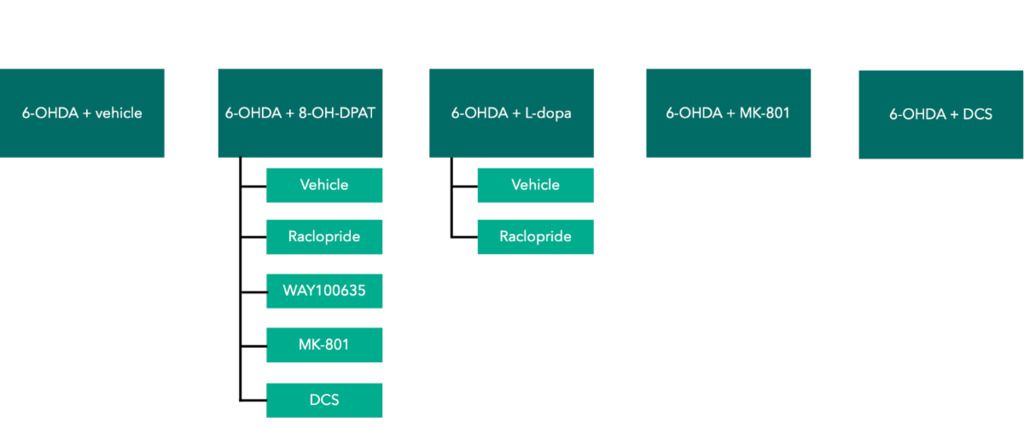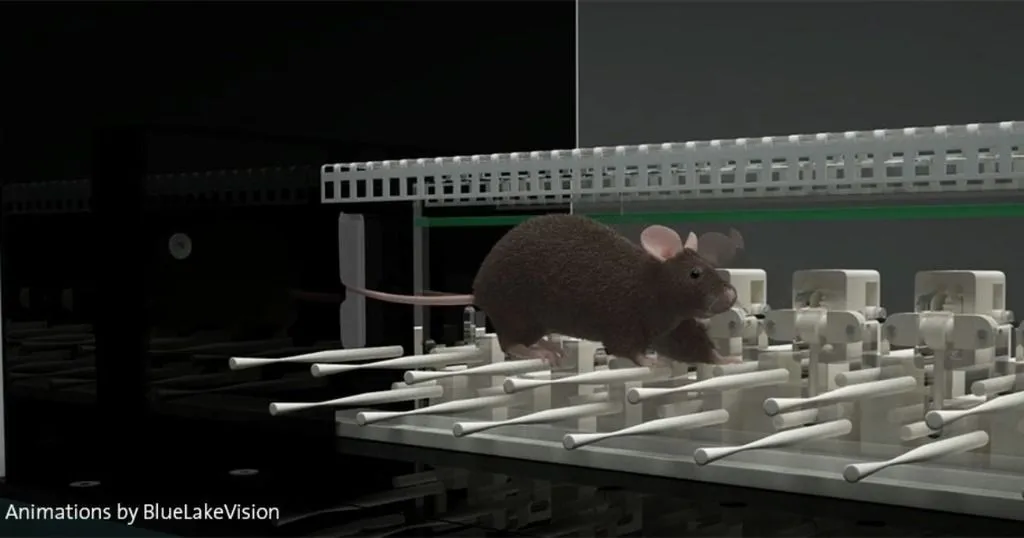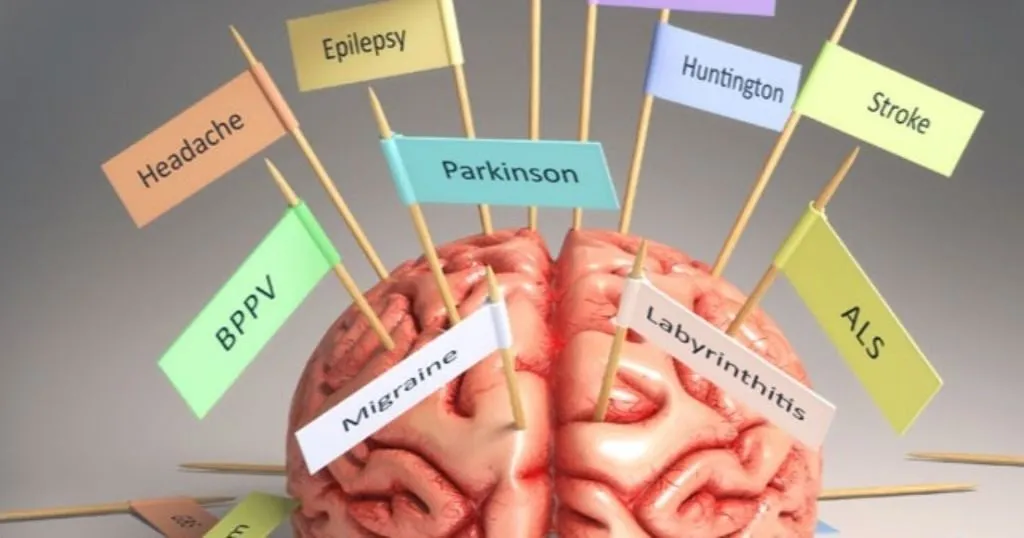A 5-HT1A agonist and NMDA antagonist against Parkinson’s disease
Reducing side effects of L-Dopa with 5-HT1A receptor agonists can improve motor activity in a Parkinson’s disease model when combined with NMDA antagonists.
Posted by
Published on
Thu 03 Aug. 2023
Topics
| EthoVision XT | Motor Performance | Open Field | Parkinson's Disease | Rats |

Parkinson’s disease is a medical condition that is well-known for a common symptom; a resting tremor. Other symptoms are for example postural abnormalities, difficulties with voluntary movement and rigidity. Often, Parkinson's disease patients are prescribed L-dopa, the precursor to dopamine, in the early stages of their disease, but there are long-term use side effects in the form of involuntary motor complications. Therefore, scientists from the Capital Medical University in Beijing researched a way to reduce these symptoms.
L-dopa effects compared to 5-HT1A receptor agonists
Based on other studies, they tested among others the effect of 8-OH-DPAT (a 5-HT1A receptor agonist), and that of L-dopa on a Parkinson’s disease rat model. Various kinds of these agonists are often used together with L-dopa in order to reduce the long-term use side effects. However, the effect of only 8-OH-DPAT on Parkinson's disease was not tested before. The researchers also tested other drugs and (ant)agonists combined with 8-OH-DPAT.
In the current study a 6-OHDA-lesioned rat model was used, created by injecting 6-OHDA into the brain. This causes changes in basal ganglia circuitry, which is characteristic of Parkinson's disease in humans. After two weeks of recovery, all rats received an apomorphine injection (a Parkinson's disease treatment). Then, for 30 minutes their behavior was tested to see which rats had a minimum of 5 net contralateral rotations/min. These rats were selected for further testing, a.o. brainwave analysis (see original article for description and test results) and behavioral analyses.
Forepaw adjusting steps
Experimenters tested the rats’ forelimb akinesia using the forepaw adjusting steps (FAS) test. They hold the rats’ hindlimbs and one forelimb, moving it sideways across a table for 90 cm in 10 seconds. Both forelimbs were tested multiple times in both directions, and the number of steps the rats took to stay balanced were counted. More steps indicates better motor ability. The effect of 8-OH-DPAT on the rats was similar to that of L-dopa, which shows that it improves Parkinson's disease’s akinesia.
Parkinson's disease combined drug treatment
Further experiments used rats that were injected with various kinds of drugs, or vehicle (0,9% saline), to test these drugs’ effectiveness. Several of the non-vehicle injected rats were in turn divided over more groups (see fig. 1) and received additional drugs 30 minutes after the first injection. All 8-OH-DPAT-injected rats received either vehicle, raclopride, WAY100635, MK-801 or DCS, and all L-dopa-injected rats received either vehicle or raclopride. Raclopride is a common Parkinson's disease treatment in trials, and WAY100635 is a 5-HT1A receptor antagonist (whereas 8-OH-DPAT is an agonist). MK-801 is an NMDA receptor antagonist and DCS is an NMDA agonist, i.e. they have more or less opposing effects. 
Figure 1: The various treatment combinations used in the experiments by Jiang et al.
Open field tests and motor symptoms
Each rat, treated according to fig. 1, could explore an open arena for 10 minutes. Those sessions were recorded with a camera that was connected to Noldus EthoVision XT. The program automatically tracked the distance travelled, the complete route the rat travelled during this time period, and its exact position in the cage related to time. This drew a very clear image of both the types of movements the rats carried out during the experiment and potential motor symptoms (see original paper for images). The analysis pointed out that both 8-OH-DPAT and L-dopa increased rats’ locomotor activity compared to vehicle-treated rats. Both also increased movement velocity, though the effect lasted longer in L-dopa treated rats.
Interaction between the 5-HT1A receptor and the NMDA receptor
This shows that 8-OH-DPAT is indeed able to significantly reduce motor deficit in the used rat model, by activating the 5-HT1A receptor. On top of that, the scientist also applied NMDA receptor antagonist MK-801 and agonist DCS. Through this, it seems that the ability of 8-OH-DPAT to improve motor function is related to the interaction between the two receptors (5-HT1A and NMDA). If and how exactly this interaction improves Parkinson's disease motor symptoms is still not clear.
Abnormal involuntary movements test
The rats that were injected with either only vehicle or only with L-dopa underwent another behavioral test, checking for abnormal involuntary movements (AIMs). A vertical, clear plastic cylinder was the tool that each rat was placed inside. Exploring rats tend to stand on their hind limbs and place their forelimbs against a vertical surface. AIMs of limbs, axis and tongue were scored on severity for one minute every 10 minutes, for a total of 120 minutes. The scientists found that AIMs were already triggered when the L-dopa dose was still quite low.
The potential of 5-HT1A receptor agonist and NMDA receptor antagonist
This study pointed to the 5-HT1A receptor agonist (8-OH-DPAT) being capable of improving Parkinson’s disease motor function when used in a 6-OHDA-lesioned rodent model. This effect might take place through 8-OH-DPAT modulating NMDA receptors, or through a different mechanism caused by NMDA antagonism. This should be studied in further research.
Original article
Jiang, X., Liang, P., Wang, K., Jia, J., & Wang, X. (2022). Serotonin 1A receptor agonist modulation of motor deficits and cortical oscillations by NMDA receptor interaction in parkinsonian rats. Neuropharmacology, 203, 108881.
Related Posts

How to study ataxia

How memory loss caused by diabetes was prevented in transgenic mice

